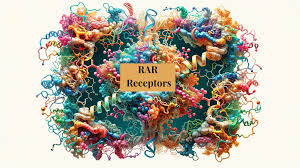
Retinoic Acid Receptors and Importance in Skincare
Retinoic acid receptors (RARs) are critical regulators of skin health and are pivotal in the treatment of various dermatological conditions, including aging, hyperpigmentation, and acne. These nuclear receptors, namely RAR alpha (α), beta (β), and gamma (γ), play distinct roles in cellular processes by modulating gene expression. Understanding how different RARs influence these pathways can help in choosing the appropriate retinoid creams and ointments—such as adapalene, tretinoin, tazarotene, and trifarotene—based on their specificity and activity towards different RARs.
Comparison of Retinoic Acid Receptors
There are three main RAR receptors that are understood enough to be targets of skincare treatments to treat skin concerns like aging, acne and hyperpigmentation. Their actions are described below.
Retinoic acid receptor alpha
RAR α
RAR alpha has several pathways that get turned on that play a role in skin care. Tretinoin and tazarotene bind RAR alpha.
Tazarotene shows stronger binding affinity to RARs, including RAR α, compared to tretinoin. While tretinoin (all-trans retinoic acid) is a first-generation retinoid that has a natural affinity for all three RARs (α, β, and γ), its binding efficiency is somewhat less selective and potent than that of tazarotene. Despite tazarotene’s stronger binding to RAR α, the choice between tretinoin and tazarotene for a specific condition should consider factors such as the condition’s severity, the skin’s sensitivity, and the individual’s Baumann Skin Type. Each retinoid has a unique profile that may make it more suitable for certain skin types and conditions.
RAR α and Skin Aging
RAR α plays a pivotal role in the skin’s aging process and its treatment. It is directly involved in the regulation of genes responsible for collagen production, a critical protein for skin elasticity and firmness. Activation of RAR α by retinoids such as tretinoin leads to increased collagen synthesis, contributing significantly to reducing the appearance of fine lines and wrinkles. This effect on collagen production underlines the potent anti-aging properties of RAR α-activating retinoids, making them foundational in dermatological approaches to combat signs of aging.
Furthermore, RAR α activation promotes skin renewal and may help in repairing photo-damaged skin. By enhancing the turnover of skin cells, it helps in the removal of damaged cells and stimulates the growth of a healthier skin layer. This regenerative capacity is crucial for maintaining skin vitality and reducing the cumulative impacts of environmental exposure on skin aging.
RAR α and Pigmentation
RAR α modulates the activity of genes involved in melanin production, the pigment responsible for skin color. By regulating these pathways, RAR α-activating retinoids can help correct hyperpigmentation disorders, such as age spots and melasma, leading to a more even skin tone. This modulation of pigmentation processes is particularly beneficial in the context of photoaging, where uneven pigmentation is a common concern.
RAR α also plays a role in the normalization of pigment distribution. By accelerating cellular turnover, it increases desquamation and facilitates the quicker removal of hyperpigmented skin cells, enhancing the effectiveness of treatments aimed at reducing visible pigmentation.
RAR α and Acne
RAR α regulates genes that control keratinocyte proliferation and differentiation, processes that, when dysregulated, contribute to acne development. Activation of RAR α leads to decreased cohesiveness of keratinocytes within the follicular epithelium, preventing comedone formation and promoting the resolution of existing lesions.
RAR α also modulated sebum production and inflammation, two additional critical factors in acne pathogenesis. By modulating these processes, RAR α-activating retinoids not only clear existing acne lesions but also prevent new ones from forming. This comprehensive action makes RAR α a central target in acne treatment strategies.
RAR b
RAR β
Research suggests that RAR β may contribute to the regulation of genes involved in the extracellular matrix’s maintenance, including collagen and elastin. This regulation is crucial for skin elasticity, firmness, and the reduction of fine lines and wrinkles. It is thought that RAR β may play a role in the modulation of melanin synthesis pathways and in the regulation of pigment cell (melanocyte) biology. Retinoids that activate RAR β could help normalize pigment production and contribute to the reduction of hyperpigmentation disorders such as melasma and post-inflammatory hyperpigmentation.
RAR β may influence skin renewal and sebaceous gland function as part of its broader regulatory impact on skin homeostasis. By modulating these processes, retinoids acting on RAR β can help normalize the shedding of skin cells in the follicle, reducing the likelihood of pore blockages that lead to acne formations. Furthermore, the regulatory actions of RAR β could complement the direct effects of RAR α and γ on keratinocyte differentiation and proliferation, offering a multi-faceted approach to acne treatment that addresses both the symptoms and underlying causes of acne.
RAR β plays a supportive yet essential role in skin health, complementing the activities of RAR α and γ. Through its involvement in collagen production, pigmentation regulation, and acne management, RAR β contributes to the comprehensive therapeutic effects of retinoids in dermatology. Understanding these nuanced roles enables dermatologists to tailor treatments more precisely, potentially leading to improved outcomes for patients with various skin conditions.
RAR β and Aging
RAR β’s involvement in aging and collagen synthesis, although less documented compared to RAR α and γ, is significant for skin health and regeneration. Research suggests that RAR β may contribute to the regulation of genes involved in the extracellular matrix’s maintenance, including collagen and elastin. This regulation is crucial for skin elasticity, firmness, and the reduction of fine lines and wrinkles. By influencing these pathways, RAR β could support the skin’s natural repair processes, potentially mitigating some aging signs. The activation of RAR β by certain retinoids may, therefore, complement the more pronounced effects of RAR α activation on skin aging, offering a more holistic approach to anti-aging treatments.
RAR β and Pigmentation
The precise mechanisms through which RAR β influences pigmentation remain an area of ongoing investigation. However, it is thought that RAR β may play a role in the modulation of melanin synthesis pathways and in the regulation of pigment cell (melanocyte) biology. By affecting these cellular processes, retinoids that activate RAR β could help normalize pigment production and contribute to the reduction of hyperpigmentation disorders such as melasma and post-inflammatory hyperpigmentation. This effect, in conjunction with other skin renewal and pigment-dispersing actions of retinoids, suggests that RAR β activity is part of a complex interplay that addresses pigmentation issues.
RAR β and Acne
In the context of acne, RAR β’s role, while indirect, is nonetheless important. It is believed that RAR β may influence skin renewal and sebaceous gland function as part of its broader regulatory impact on skin homeostasis. By modulating these processes, retinoids acting on RAR β can help normalize the shedding of skin cells in the follicle, reducing the likelihood of pore blockages that lead to acne formations. Furthermore, the regulatory actions of RAR β could complement the direct effects of RAR α and γ on keratinocyte differentiation and proliferation, offering a multi-faceted approach to acne treatment that addresses both the symptoms and underlying causes of acne.
RAR G
RAR γ
RAR γ is notably the most abundant retinoic acid receptor in the skin, playing a crucial role in epidermal maturation and barrier function. Its activation is central to modulating gene expression related to skin cell growth and differentiation.
RAR γ and Skin Aging
In the context of aging, RAR γ’s involvement goes beyond mere cell turnover; it also includes the stimulation of collagen production in the dermis, which is fundamental for reducing wrinkles and improving skin firmness. The activation of RAR γ by specific retinoids can enhance the skin’s overall structure and function, leading to visible anti-aging effects. This receptor’s action on collagen and other matrix components underlines its importance in treatments aimed at reversing or mitigating the signs of skin aging.
RAR γ and Pigmentation
In pigmentation disorders, RAR γ’s role is multifaceted. By promoting epidermal turnover, RAR γ activation can expedite the removal of hyperpigmented skin layers, leading to a more even skin tone. Moreover, there is evidence to suggest that RAR γ may influence the melanogenesis process indirectly through its effects on keratinocyte and melanocyte interactions. By normalizing these cellular dynamics, retinoids targeting RAR γ can help in managing conditions like melasma and post-inflammatory hyperpigmentation, contributing to a reduction in unwanted pigmentation and an improvement in overall skin appearance.
RAR γ and Acne
RAR γ’s significance in acne treatment is well-documented and largely attributed to its profound impact on follicular epithelial cells. Activation of RAR γ leads to the modulation of keratinocyte proliferation and differentiation, which in turn can decrease comedogenesis—the formation of comedones or acne lesions. Moreover, RAR γ influences sebaceous gland activity and reduces the inflammatory processes associated with acne. This comprehensive approach not only targets the visible symptoms of acne but also addresses the root causes, including abnormal desquamation, excess sebum production, and inflammation. Retinoids such as adapalene and trifarotene, which are selective for RAR β and γ, with a particular emphasis on RAR γ, are thus highly effective in the topical treatment of acne.
RAR γ and Toll like Receptors
RAR γ is particularly noteworthy for its role in modulating Toll-like Receptor 2 TLR2 activity and thus influencing acne development. RAR γ, prevalent in the skin, impacts keratinocyte differentiation, sebaceous gland function, and the immune response, all of which are relevant to acne pathogenesis. The connection between RARs and TLR2 occurs through the regulatory effects of retinoids (activating RARs) on gene expression that controls skin cell behavior and immune responses. Specifically, retinoids can modulate the expression of genes involved in the innate immune response, including those related to TLR2. By regulating TLR2 expression and signaling, RARs, particularly RAR γ, can reduce the inflammatory response triggered by acne-causing bacteria such as P. acnes. This action helps in mitigating inflammation and potentially decreasing the severity of acne lesions. Thus, RAR γ’s influence on TLR2 represents a crucial intersection between retinoid therapy and acne management, highlighting the importance of retinoids in targeting both the inflammatory and proliferative aspects of acne.
Comparison of RAR binding with Various Retinoids
There are 4 main retinoid compounds used topically in dermatology to treat acne, melasma, and skin aging. Their activity differs based on their strength, formulation, and which retinoid acid receptor it binds.
Adapalene: Selective for RAR β and γ, adapalene is effective in treating acne with less irritation compared to tretinoin, making it suitable for sensitive skin types.
Tretinoin: Activates all RARs, with a significant effect on RAR α, making it very effective for anti-aging, acne, and pigmentation issues, albeit with higher irritation potential.
Tazarotene: A third-generation retinoid with activity across all RARs but with a particular affinity for RAR β and γ. It is potent for acne, psoriasis, and signs of aging but can be more irritating.
Trifarotene: The first fourth-generation retinoid selective for RAR γ, offering targeted action for acne treatment with a favorable tolerability profile.
In summary, the choice between adapalene, tretinoin, tazarotene, and trifarotene should be informed by their RAR specificity, the dermatological condition being treated, and the individual’s Baumann Skin Type. These considerations will ensure the most effective and personalized approach to skin care and treatment.
There is a lot of complicated science involved in designing a skincare routine that is best for you skin type. Let us help!


